Ambiguity in Game Design: What developers can learn from Dear Esther
I decided to write this blog post about Dear Esther because it was the first game in the relatively new genre of ‘Walking Simulators’. It is revolutionary in many ways, most notably for getting rid of video game conventions and exploring what lies at the core of interactive experiences. What do we really need to present to the player to create a ‘meaningful’ experience?
This post will dive deep into Dear Esther’s creation, intention, and reception and try to draw conclusions from this unique video game experience. Note that this post does contain spoilers and a brief description of the ending, so if you have not yet played Dear Esther you should experience it yourself before reading this post.
Game overview
Dear Esther is a single-player, first-person game in which the player slowly explores a deserted island. The story is presented via voice-over letter fragments read by a male narrator to a woman called Esther. These voice-overs are triggered when the player reaches specific locations on the island. The mechanics of the game are very limited; the player can only walk. There is no running or sprinting, no jumping and no interactions with items or the environment, forcing the player to focus on the story he is presented with.
The game takes place after a tragic car accident in which Esther was killed. The narrator reflects on her death and their time together as the player walks the shores of the lonely island. A series of other characters are mentioned: Paul, Jakobson, Donelly and the Hermit. However, as the game progresses, more and more surreal details appear in the environment, raising the question if the island and these characters really exist. Over time, the narration grows increasingly confusing and succumbs to madness.
It is up to the player to figure out what it all really means.
Development
Dear Esther was developed by thechineseroom; however, it started as a Half-Life 2 mod mainly developed by Dan Pinchbeck. In 2007, Pinchbeck worked in the field of game studies at the University of Portsmouth. After finishing his Ph.D., he grew frustrated with the theoretic and slow nature of game studies and applied to the Arts & Humanities Research Council to fund the creation of a series of mods to quickly test various ideas rather than theorizing over them for a long time [1, 3:00 min]. After receiving the funding, Pinchbeck went on to create four mods: Conscientious Objector for Doom 3 and Antlion Soccer, Korsakovia and Dear Esther for Half-Life 2. All these mods are available on ModDB and were developed under the name of thechineseroom with a development team consisting of Dan Pinchbeck, Adam Griffiths, Jessica Curry and others.
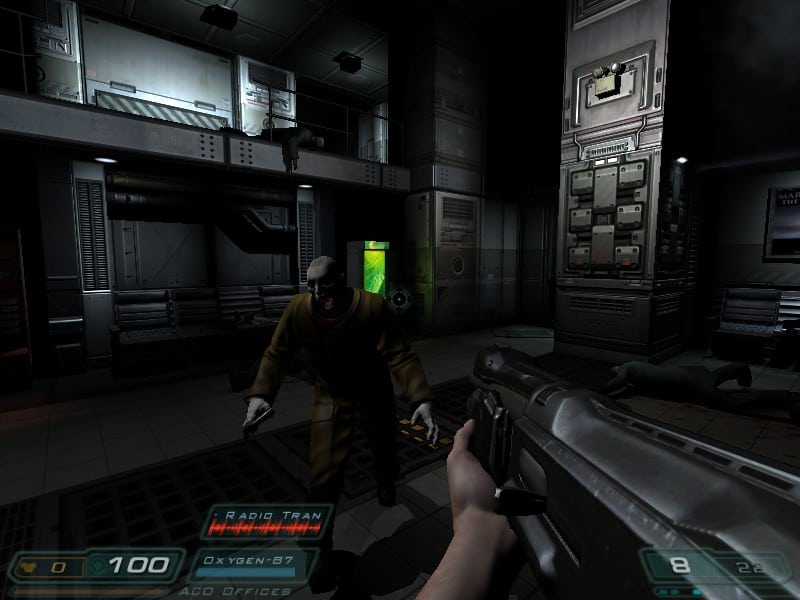
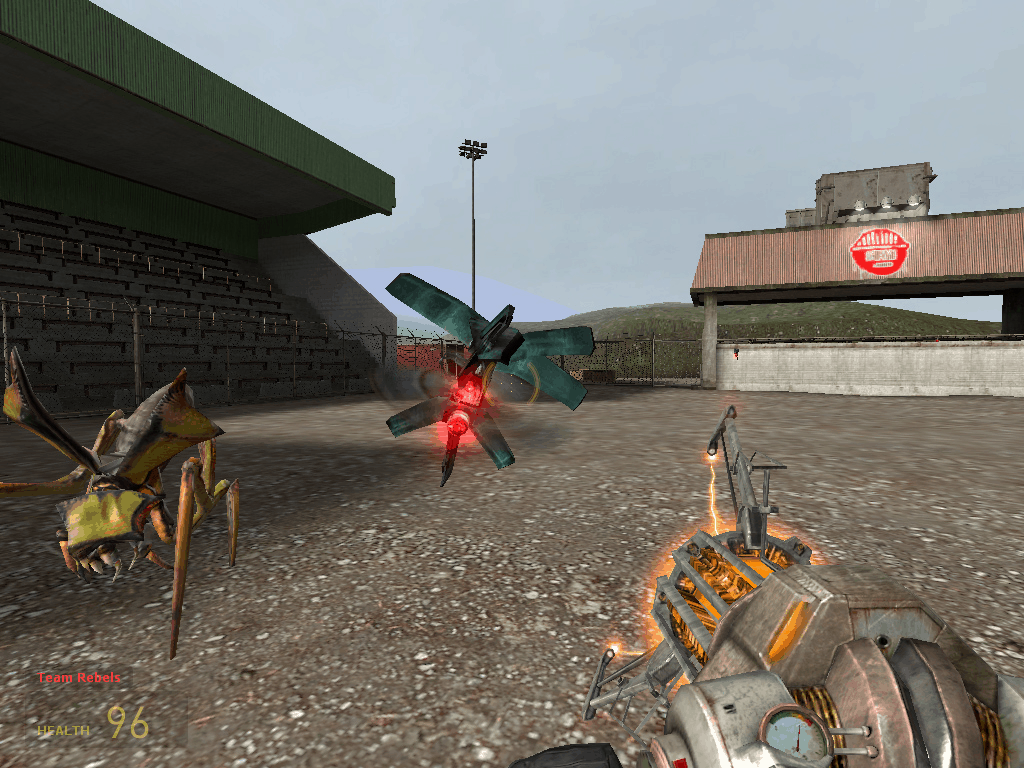
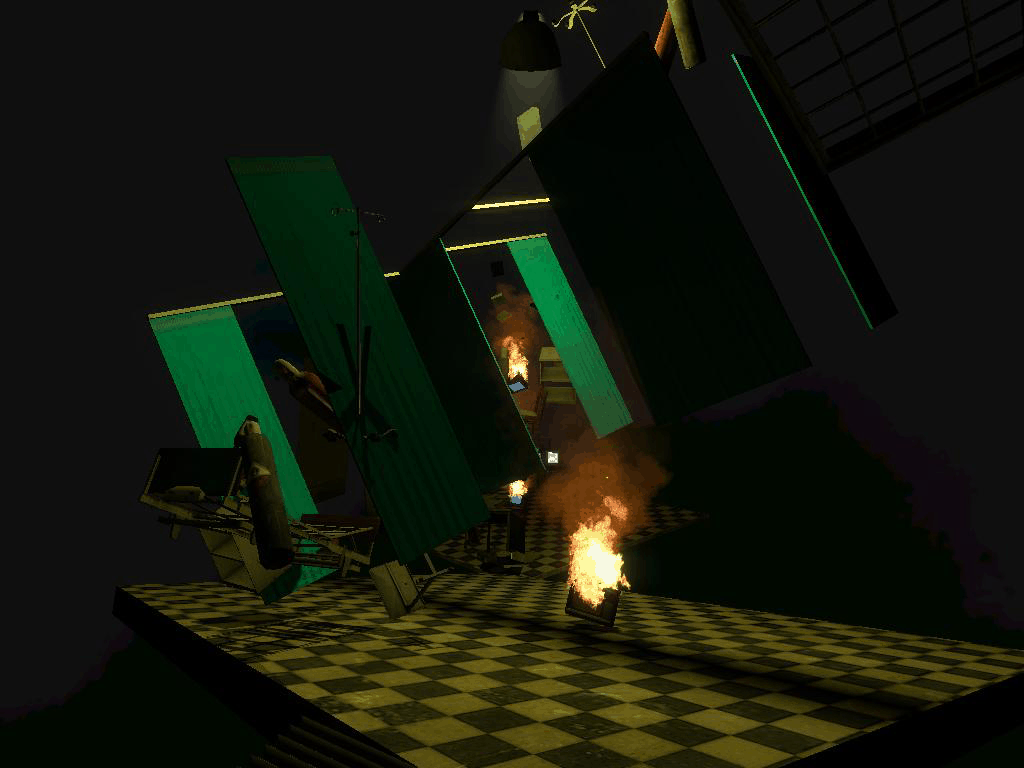
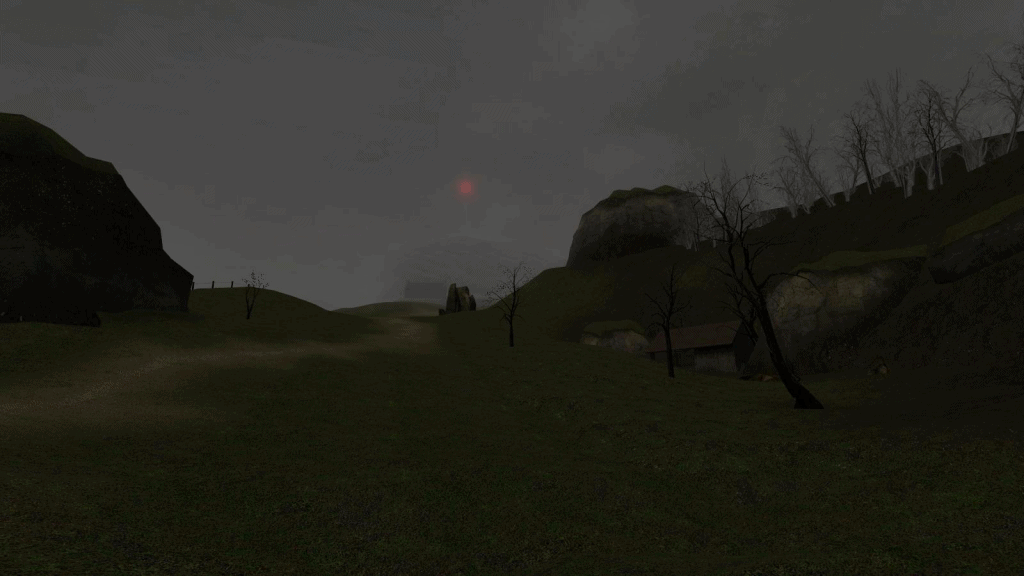
The overall research topic of the mods was to test out the boundaries of the well-known mechanics in games by systematically breaking design rules and then testing which experiences still worked or why theydidn’t work [1, 8:39 min]. Conscientious Objector is an FPS where the enemies get back up again after being shot, reversing the rule of players successively simplifying game environments by removing enemies. Furthermore, an unhelpful NPC would constantly tell the player that he’s useless and rubbish at his job; in contrast to the usually helpful NPCs present in games at the time. Korsakovia is a horror game, scaring the players by being unpredictable and systematically breaking any design rules and methods other games would follow [1, 14:41 min]. The physics in Korsakovia don’t work like in the real world, walls are traversable, enemies are designed so the players can’t see which direction they are facing and the game’s sounds present the player with unidentifiable static and unfinished sentences.
“If you break every single rule that other developers aren’t breaking, which of those rules counted and which were actually something you could get away with?” [1, 15:34 min]
Dear Esther, being part of the same batch of research mods, was designed to test which rules and mechanics can be removed from games while still presenting the players with an engaging experience [1, 18:55 min]. Thus, nearly all mechanics were removed from the game, leaving the players only with the ability to walk. Is it possible to have nothing but the story to keep the player engaged, and what kind of experience does that leave? What do the spaces freed by getting rid of all these elements allow you to do instead? [2] These were the questions that drove the design and development of Dear Esther.
After the initial release of the free mod in 2008, Dear Esther was very successful and was one of the most-downloaded mods of the time. In 2009, Pinchbeck was contacted by Robert Briscoe who was interested in remaking the (very simple) environments of the game. Briscoe, seeing a lot of potential in the game, had felt a disconnection between the audio and visual experiences because the visual detail was inconsistent with the narrative detail [9, 2:42 min]. A commercial remake of the game for PC with environments by Briscoe and a new soundtrack by Jessica Curry was released in 2012. In 2016, another remake of the game called Dear Esther: Landmark Edition was released for PlayStation 4 and Xbox One. The Landmark Edition features a developer’s commentary by Pinchbeck, Curry, and Briscoe.
Ambiguity in story design
At the center of Dear Esther’s story lies a tragic traffic accident which killed Esther and possibly the narrator himself. Little more can be said with certainty, as the game prides itself in ambiguity and leaves most of the story to the player’s interpretation of the voice-over segments he is presented with. While other characters such as Paul or the Hermit are mentioned, it is also unclear if these really exist or are merely figments of the narrator’s imagination or parts of the narrator’s personality himself. The same can be said about the island the game takes place on.
Furthermore, each time a player triggers a voice-over segment, one out of four possibilities is randomly chosen and presented to the player. These voice-over lines may contain different information or even contradict one another [4]. There is no correct solution to what’s really going on and the designers have no direct control over which of the randomized voice-over lines the player is presented with [5, 1:20 min]. This creates a big space for the player’s imagination to work with and allows for an enormous number of different interpretations of the story, which have been vividly discussed on the game’s forums.

In his GDC talk ‘Dear Esther: Making an Indie Success Out of an Experimental Mod’, Dan Pinchbeck talks about the idea of the experience vacuum: “If you give the players enough vacuum space, they will fill it. […] Lack of stimulation is not lack of experience. Lack of stimulation allows different kinds of reflective emotional experiences for the player to evolve and get out of it” [6, 21:24 min]. Hence, the gap that opened by taking out most traditional game mechanics is filled with time for the players to reflect on the experience they are presented with. “These kinds of vacuums fill with headspace; they don’t fill with boredom” [6, 22:54 min].
Pinchbeck argues that many games bombard the player with constant stimulation and action and then fail because they cannot keep up with this. He mentions the Tibetan village scenes from Uncharted 2 and the return to the Ishimura from Dead Space 2 as positive examples from other games where the players are given a few minutes of breathing space between action scenes to reflect on their situations and fill the gaps using their imagination [7, Chapter 2]. This allows for a deeper engagement and immersion, as well as stronger and different emotions evoked in the player:
“It’s impossible to feel sad fast. It’s impossible to feel rage slowly. You simply don’t have access to that emotional range in your players, if you’re stimulating them all the time.” [1, 37:25 min].
Designing this ambiguity was no simple task. In [5], Pinchbeck mentions the functionalist approach to narrative introduced by Roland Barthes [8]. Barthes identifies functions and indices as the building blocks of a story, where functions are the units of what’s actually happening and indices are about the atmosphere, surrounding, and details of what’s going on. In Dear Esther, the player is presented mostly with narrative indices, while most functions are left to his imagination. “There’s practically no functions in this at all, it’s all indices. The story of Dear Esther doesn’t really explicitly tell you anything. It just suggests things that could have happened” [5, 11:58min]. As an example, the game only states about seven facts about the character Paul; however, there have been page-long discussions about him on the forums. Players have spent hours thinking and interpreting these seven facts.

Isolated facts and ideas like these are deliberately planted throughout the narrative. Pinchbeck talks about these as symbolic assets [6, 6:48 min]. For example, the narrator talks about gulls and flight throughout the game, creating a symbol for the developers to play with and manipulate. This symbolic asset can be used in the narrative, but also in environmental storytelling. While walking around the island, these “little dripped things” and symbolic assets will take root in the player and begin to grow, creating an emotional journey [6, 21:24 min]. In the case of the gull and flight symbols, this is taken to the extreme at the end of the game where the player seemingly turns into a gull and flies over the beach.
“It’s actually perfectly fine for the players not to understand. They don’t need to be told, they don’t need explicit plots, they don’t need explicit causality. [..] If they’re feeling, it’s fine. If they’re engaged emotionally, they don’t need to be engaged intellectually.” [6, 24:04 min]
Ambiguity in environmental storytelling
The ambiguity of the narrative is underlined and represented in the environment, where some physical objects are randomized as well. Players will encounter different objects in different playthroughs, allowing for different interpretations of what’s going on. In the developer’s commentary, Pinchbeck, Curry and Briscoe identify the randomized chance of an ultrasound picture inside a house appearing as “the pinnacle of it, because the idea that Esther was pregnant when she died changes everything emotionally” [7, Chapter 2].
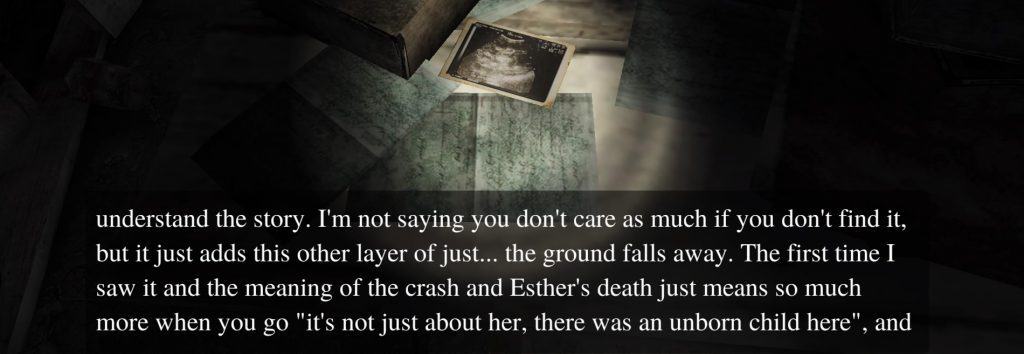
Another example of this symbolism is a short gully in the environment just before the end of Chapter 2, where the player can find hundreds of books that have been dumped here. In the audio commentary, Pinchbeck notes that this is one of his favorite bits in the game because “there’s the suggestion that nothing you’re seeing is real because there’s no way that this can exist” [7, Chapter 2].
In addition to providing another dimension to possible interpretations of the story, the environment works as a mirror of the narrator’s emotional and mental state [6, 10:16 min]. Rather than telling the players how they are supposed to feel, Dear Estherphysically places them within that emotional state and represents it around them. In his GDC talk ‘The Art of Dear Esther’, Rob Briscoe stated that he wanted to “make the environment more than a backdrop, make it an immersion tank” [9, 2:47 min]. Briscoe notes that the Hebridean environment feels very hostile, which is supported by the harsh weather. Details like several shipwrecks and a generally very dirty and polluted look make the players uncomfortable and underline that “these happenings have been plaguing the island for hundreds of years. The island is this cursed place” [9, 11:50 min]. Note that the game’s overall setting on a Hebridean Island however is due to the availability of these assets for Half-Life 2 mods [7, Chapter 1].
Environmental storytelling is most prominent in chapter 3: The Caves, which is designed to be a journey through the narrator’s own body and mind [9, 17:30 min]. While the first two chapters present the player with a brown/grey polluted island, the caves are a series of very colorful corridors and openings. The player’s journey through the caves is guided by following openings and signposts of colorful contrast through the surroundings.

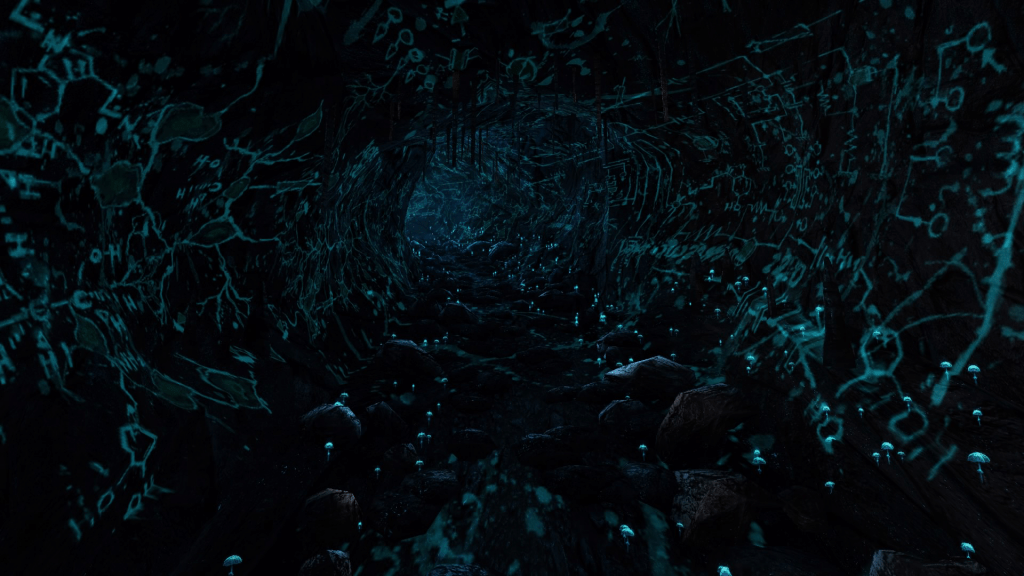
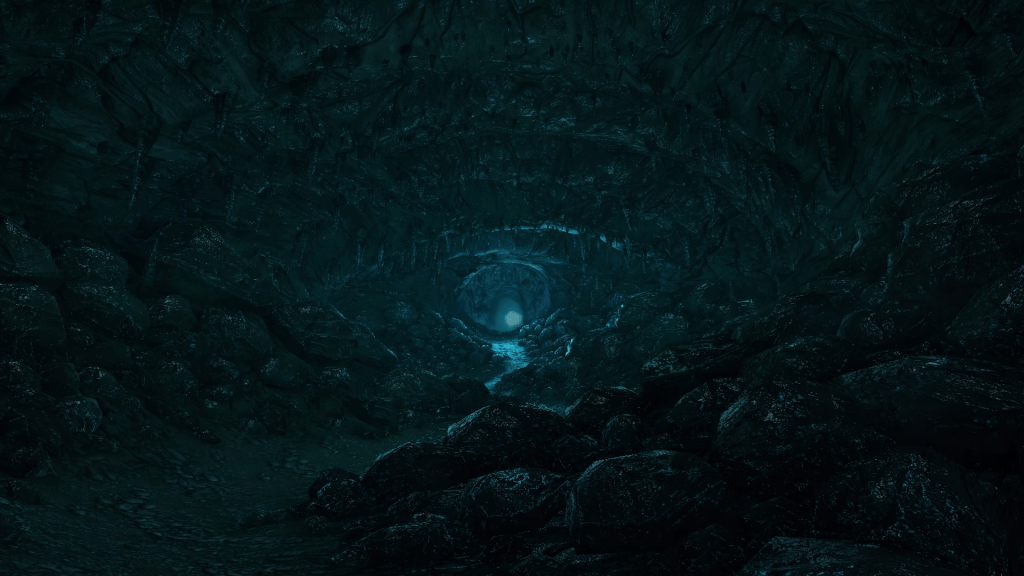

When traversing the caves, four places stand out for their particularly symbolic meaningfulness:
- A blue cave with red/orange pillars, which is representative of the narrator’s heart [9, 18:20 min].
- A long corridor with wild writings on the wall which have been painted over and over to the point of senselessness and obscurity. Pinchbeck notes that “you would have to be insane or very, very disturbed to actually do this” and that “you [the player] kind of know that you’re getting towards the end of the serenity into something that’s a bit more disturbed” [7, Chapter 3].
- The exit of the cave, which is shaped like an eye. Briscoe notes that this scene “is really, really iconic because it kind of brings this idea of the caves being this inward journey through the body together. It’s really like a symbol of rebirth” [7, Chapter 3].
- At one point in the caves, the player falls into the water and enters a dreamlike underwater scene on a highway. This scene is randomized and can either show the scene of the accident or a hospital gurney. Jessica Curry notes that this scene is her favorite part in the game because it’s so shocking, surreal and beautiful. She notes that the sounds of a baby’s heartbeat further add to the ambiguity and room for interpretation [7, Chapter 3].
Like the eye symbol, the game is full of environments with a very deliberate composition. More often than not, the hills and rocks of the island are formed in very particular ways, allowing for very distinct and memorable landmarks. For example, Pinchbeck notes that there’s a hill in the background in the shape of a woman lying on her side [7, Chapter 4]. The biggest example for this deliberate composition is the radio tower the player reaches at the very end of the game. It can be seen looming over the environment in many scenes, its red blinking light being in stark contrast to the rest of the environment. Rock formations often open up in just the right angle to show the player a glimpse of the radio tower — a result of very deliberate composition and game design. The game even starts with the player standing on a small walkway looking at the radio tower in the distance.

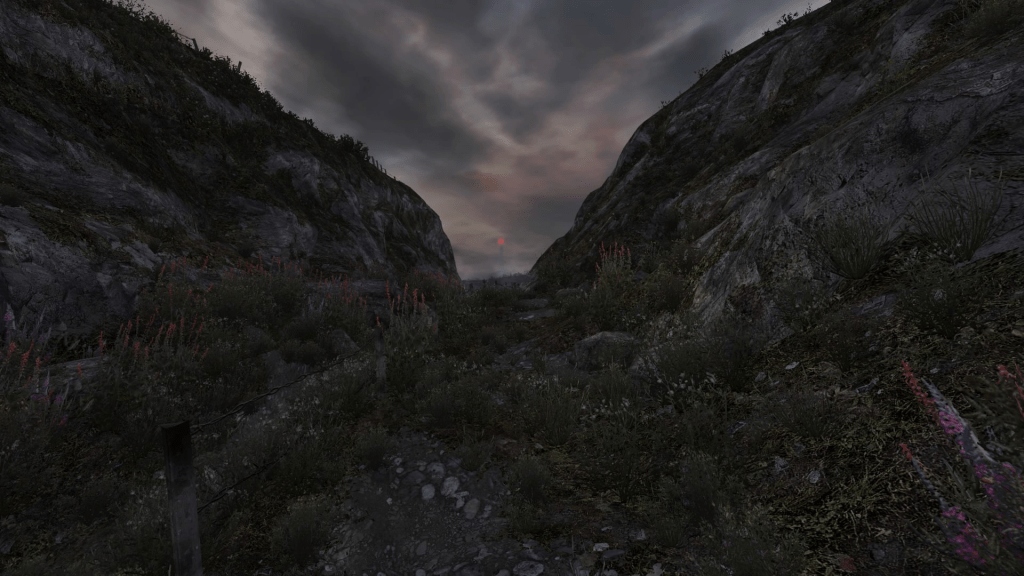
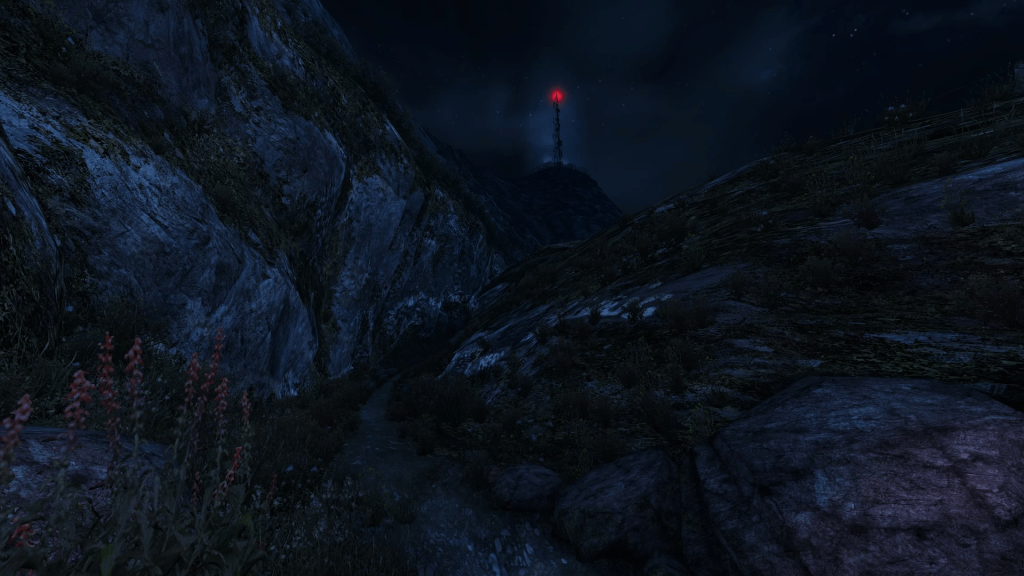

Briscoe notes that subliminal signposts like this are used throughout the game to unconsciously guide the player [9, 16:20 min]. The radio tower is designed to work like the citadel in Half-Life 2, which lets the players know how near they are to the end of the game by their proximity to it.
“[You] know exactly from the beginning of the game, virtually right from the start, you know where you’re going, you know where the game’s going to end […]. It’s always there – that red light.” [7, Chapter 2]
By subtly guiding the one mechanic the player has left and making sure they cannot get lost, the developers leave the player with no challenge, giving him the room (“the vacuum”) to reflect on what he is presented with – “you can’t expect a player to engage with a complicated, abstract story whilst hurling ballistics at them constantly” [10]. The sum of unconscious but deliberate signs in the environment which work in communion with the symbols presented in the voice-over leaves the player with a wealth of symbols and topics to think about while walking over the island.
Reflections on Dear Esther
Dan Pinchbeck, Jessica Curry, and Robert Briscoe have created an extraordinary piece of video game art with many lessons to learn for fellow game developers. Every detail and second of the experience has been deliberately crafted with the design goal in mind: exploring the borders and core values of narrative game design. Its roots in game studies speak volumes for the sophistication and value of the concepts behind the game.
However, the game is not without its problems. The label of a ‘Walking Simulator’ was meant to criticize the fact that there is not much to do in the game and many players, who had a difficult time interpreting and losing themselves in the very abstract and intellectual narrative and environment, were bored. Robert Briscoe stated that he first took offense when the game was called a Walking Simulator [7, Chapter 4].

Additionally, many players who put a lot of time into replaying and interpreting the game were frustrated or offended when they realized there was no one correct solution to the mystery. The fact that some voice-overs contradict each other felt to some like their careful reflection and interpretation of the clues presented was a waste of time. It is also unclear if the added benefit of every player being presented a different surrounding and story is worth the risk of some of these random permutations being less interesting than others. For example, the developers singled out the ultrasound picture as one of the strongest images in the game – while it is already very hard to find, it randomly won’t appear to a number of players.
However; in the end, the presence of these permutations and random elements won’t matter or even be evident to players who only play through the game once or don’t enter the (albeit very active) discussion about the game. While other games like Firewatch present each player very different experiences that are personalized to them by reacting to choices they have made in the past, the permutations in Dear Esther are random. The developers state that the randomness is “just to build on this idea that everyone has a unique experience and a unique interpretation of the story” [7, Chapter 1].
In my opinion, the uniqueness of the experience is less important than the intensity of it – there’s a fine line between giving players unique experiences and giving players experiences of different quality. When there are hundreds of permutations the player can experience and the designers have no influence over which ones are picked at any given point [5, 1:45 min], some of these permutations will be better or worse than others – one must be very careful when going for such an approach that the benefits outweigh the possibility of presenting the player with a single, best version of the experience (this is especially true for games using procedural generation). With very few exceptions (like the ultrasound picture), I believe that Dear Esther walks that line very well and does a great job of delivering players unique, meaningful experiences; however, this could be due to the strong ambiguity of the content itself. It’s hard to estimate if one ambiguous voice-over line is in any way superior or inferior to another.
Dear Esther was released to great critical acclaim and won a myriad of awards. It recouped its $55k in funding within five and a half hours after release [3]. It’s an extraordinary piece of software and started the genre of Walking Simulators (which is not a negative term any more), making games like Gone Home, Firewatch, The Vanishing of Ethan Carter or The Stanley Parable possible.
What we can learn

Dear Esther’s success and the emotional value it delivers clearly show that there is a lot to learn from this unique game. To summarize, the following aspects seem to be key values to take away:
- Using ambiguity: Players don’t need to be spoon-fed all the answers to the questions a game may raise. The players will use their imagination to answer these questions far better than the developers could have – in fact, oftentimes people are disappointed when they are presented with the answers to the questions they have been engaged with for so long (an example would be the endings of LOST or Firewatch, where some people felt disappointed after the mystery was answered).
However, one should note that this should not be used to avoid finding answers for logic holes and the like. The developers of Dear Esther used a deliberate system (functions and indices) to generate the ambiguity. This should be handled with care. - The experience vacuum: It’s okay to give the players a little breathing time between action scenes, they will use this time, if unconsciously, to reflect on the experience they are having. That is, if the experience gives them enough material to think about. As a result, this time for reflection will allow for a deeper emotional engagement, stronger immersion and make some kinds of emotions available that would be impossible to achieve otherwise: you can’t feel sad fast.
- Consistency of the experience: In Dear Esther, every detail benefits the overall design principles of ambiguity and room for interpretation. That is true for the writing, level design, graphics, music and narration. Every detail is in line with the concept, creating a vast experience space for the player. While this is a good goal to strive for, it’s also a very hard one to pull off.
- Transporting emotion through environment: Rather than telling the players how to feel, we can express emotion through the surroundings. By physically placing the players within an emotional state and surrounding him with a given mood, we can subconsciously guide the player’s experience. The environment can also be used to communicate ideas, which has been done at various stages in Dear Esther where the surroundings feel surreal or like the dream of a crazy person.

- Using subliminal signposting: Showing the player where he is supposed to go in a subtle way can take away from the confusion of navigating the game’s environments and give the players space to focus on their experience. Plus, seeing things like the radio tower again and again is really cool. This is also done in Half-Life 2, The Last of Us and the Uncharted series.
- Composition in level design: The level design and graphics by Rob Briscoe are outstanding in terms of composition. Very often the player comes across a formation of rocks or an opening in the cave that very deliberately looks special within the environment – be it an opening in a mountain to show the player the radio tower, aligning rocks at very distinct angles, revisiting locations from unexpected directions or simply looking at them from unusual angles. The caves stand out in this regard.
Dear Esther started the genre of Walking Simulators by questioning the conventions and rules designers have been following for decades. After Dear Esther, thechineseroom (which has since been rebranded to ‘The Chinese Room’) went on to create Amnesia: A Machine for Pigs and Everybody’s Gone to the Rapture. These games were also released to great success and deserve an examination of their own.
“The most powerful tool you have in your toolkit as a designer is the player’s imagination” [1, 34:24 min]
Sources
- Youtube: Dear Esther / Dan Pinchbeck / thechineseroom – GameCity Nights. GameCity Nottingham. (Link)
- Gamasutra: Interview: Moved By Mod — Dear Esther‘s Dan Pinchbeck. Phill Cameron. (Link)
- University of Portsmouth News: Commercial success for computer game. (Link)
- Dear Esther Wiki: Game script. (Link)
- GDC Europe 2012: Ambiguity and Abstraction in Game Writing: Lessons from Dear Esther. Dan Pinchbeck. (Link)
- GDC 2012: Dear Esther: Making an Indie Success Out of an Experimental Mod. Dan Pinchbeck. (Link)
- Dear Esther – Landmark Edition. Developer’s commentary. PS4.
- Roland Barthes: An Introduction to the Structural Analysis of Narrative. (Link)
- GDC 2012: The Art of Dear Esther – Building an Environment to tell a Story. Robert Briscoe. (Link)
- God is a Geek: Exploring Stories: An Interview with Dear Esther’s Dan Pinchbeck. Mary Goodden. (Link)
Image sources
- ModDB: Screenshots of Conscientious Objector, Antilon Soccer, Korsakovia, Dear Esther (mod version). thechineseroom on ModDB (Link)
- Youtube: Dear Esther – Official Trailer. Robert Briscoe’s channel (Link)
- Youtube: Dear Esther (2012) vs. Dear Esther (2008). SirCrest (Link)
- Screenshots: All other screenshots were taken by me in the Dear Esther: Landmark Edition on PS4






